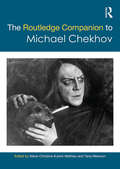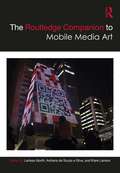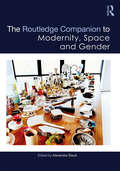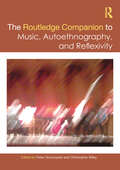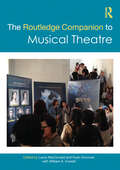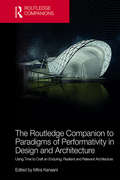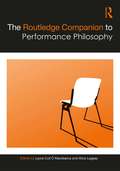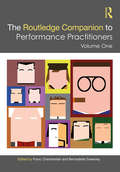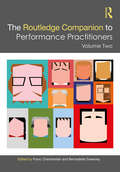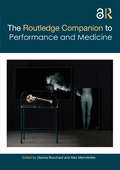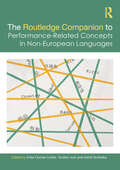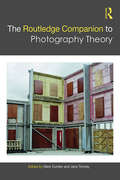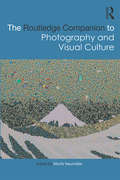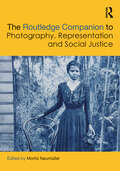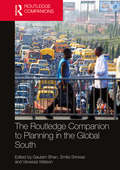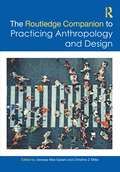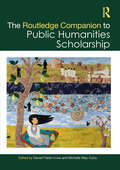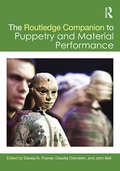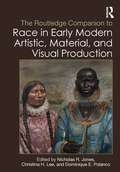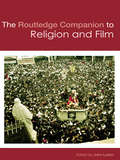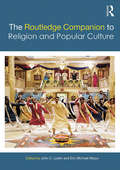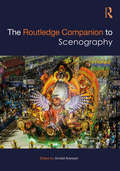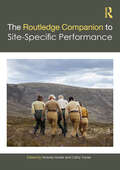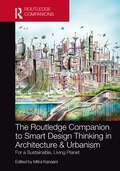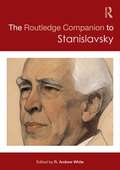- Table View
- List View
The Routledge Companion to Michael Chekhov (Routledge Companions)
by Yana Meerzon Marie Christine Autant MathieuThe Routledge Companion to Michael Chekhov brings together Chekhov specialists from around the world - theatre practitioners, theorists, historians and archivists – to provide an astonishingly comprehensive assessment of his life, work and legacy. This volume aims to connect East and West; theatre theory and practice. It reconsiders the history of Chekhov’s acting method, directing and pedagogy, using the archival documents found across the globe: in Russia, England, America, Germany, Lithuania and Switzerland. It presents Chekhov’s legacy and ideas in the framework of interdisciplinary theatre practices and theories, as well as at the crossroads of cultures, in the context of his forays into such areas as Western mime and Asian cosmology. This remarkable Companion, thoughtfully edited by two leading Chekhov scholars, will prove invaluable to students and scholars of theatre, theatre practitioners and theoreticians, and specialists in Slavic and transcultural studies. Marie-Christine Autant-Mathieu is Director of Research at the National Center For Scientific Research, and Assistant-Director of Sorbonne-CNRS Institute EUR’ORBEM. She is an historian of theatre and specialist in Russian and Soviet theatre.Yana Meerzon is Associate Professor in the Department of Theatre, University of Ottawa. Her book publications include Adapting Chekhov: The Text and Its Mutations, co-edited with Professor J. Douglas Clayton, University of Ottawa (Routlegde, 2012).
The Routledge Companion to Mobile Media Art (Routledge Media and Cultural Studies Companions)
by Larissa HjorthIn this companion, a diverse, international and interdisciplinary group of contributors and editors examine the rapidly expanding, far-reaching field of mobile media as it intersects with art across a range of spaces—theoretical, practical and conceptual. As a vehicle for—and of—the everyday, mobile media is recalibrating the relationship between art and digital networked media, and reshaping how creative practices such as writing, photography, video art and filmmaking are being conceptualized and practised. In exploring these innovations, The Routledge Companion to Mobile Media Art pulls together comprehensive, culturally nuanced and interdisciplinary approaches; considerations of broader media ecologies and histories and political, social and cultural dynamics; and critical and considered perspectives on the intersections between mobile media and art. This book is the definitive publication for researchers, artists and students interested in comprehending all the various aspects of mobile media art, covering digital media and culture, internet studies, games studies, anthropology, sociology, geography, media and communication, cultural studies and design.
The Routledge Companion to Modernity, Space and Gender
by Alexandra StaubThe Routledge Companion to Modernity, Space and Gender reframes the discussion of modernity, space and gender by examining how "modernity" has been defined in various cultural contexts of the twentieth and twenty-first centuries, how this definition has been expressed spatially and architecturally, and what effect this has had on women in their everyday lives. In doing so, this volume presents theories and methods for understanding space and gender as they relate to the development of cities, urban space and individual building types (such as housing, work spaces or commercial spaces) in both the creation of and resistance to social transformations and modern global capitalism. The book contains a diverse range of case studies from the US, Europe, the UK, and Asian countries such as China and India, which bring together a multiplicity of approaches to a continuing and common issue and reinforces the need for alternatives to the existing theoretical canon.
The Routledge Companion to Music, Autoethnography, and Reflexivity (Routledge Music Companions)
by Christopher Wiley Peter GouzouasisThe Routledge Companion to Music, Autoethnography, and Reflexivity represents a substantial contribution to the field of writing self-reflexively about an individual’s practice within music studies. In seven sections, 22 original chapters by a diverse set of contributors consider writing about personal activities from the points of view of performance, composition, musicology, and pedagogy, drawing on a range of traditions from Western art-music to popular music to ethnomusicology. A robust critical framework is presented, with coverage of: historical and critical perspectives different methodologies and their ascendancy within the academy leading debates, issues, and approaches future directions The Companion cultivates new modes of engagement in music research, enabling scholars and practitioners at all levels to identify and articulate their relationship to the wider sociocultural contexts in which they operate.
The Routledge Companion to Musical Theatre (Routledge Companions)
by William A. Everett Laura MacDonald Ryan DonovanGlobal in scope and featuring thirty-five chapters from more than fifty dance, music, and theatre scholars and practitioners, The Routledge Companion to Musical Theatre introduces the fundamentals of musical theatre studies and highlights developing global trends in practice and scholarship. Investigating the who, what, when, where, why, and how of transnational musical theatre, The Routledge Companion to Musical Theatre is a comprehensive guide for those studying the components of musical theatre, its history, practitioners, audiences, and agendas. The Companion expands the study of musical theatre to include the ways we practice and experience musicals, their engagement with technology, and their navigation of international commercial marketplaces. The Companion is the first collection to include global musical theatre in each chapter, reflecting the musical’s status as the world’s most popular theatrical form. This book brings together practice and scholarship, featuring essays by leading and emerging scholars alongside luminaries such as Chinese musical theatre composer San Bao, Tony Award-winning star André De Shields, and Tony Award-winning director Diane Paulus. This is an essential resource for students on theatre and performance courses and an invaluable text for researchers and practitioners in these areas of study.
The Routledge Companion to Paradigms of Performativity in Design and Architecture: Using Time to Craft an Enduring, Resilient and Relevant Architecture
by Mitra KanaaniThe Routledge Companion to Paradigms of Performativity in Design and Architecture focuses on a non-linear, multilateral, ethical way of design thinking, positioning the design process as a journey. It expands on the multiple facets and paradigms of performative design thinking as an emerging trend in design methodology. This edited collection explores the meaning of performativity by examining its relevance in conjunction with three fundamental principles: firmness, commodity and delight. The scope and broader meaning of performativity, performative architecture and performance-based building design are discussed in terms of how they influence today’s design thinking. With contributions from 45 expert practitioners, educators and researchers, this volume engages theory, history, technology and the human aspects of performative design thinking and its implications for the future of design.
The Routledge Companion to Performance Philosophy (Routledge Companions)
by Laura Cull Ó MaoilearcaThe Routledge Companion to Performance Philosophy is a volume of especially commissioned critical essays, conversations, collaborative, creative and performative writing mapping the key contexts, debates, methods, discourses and practices in this developing field. Firstly, the collection offers new insights on the fundamental question of how thinking happens: where, when, how and by whom philosophy is performed. Secondly, it provides a plurality of new accounts of performance and performativity – as the production of ideas, bodies and knowledges – in the arts and beyond. Comprising texts written by international artists, philosophers and scholars from multiple disciplines, the essays engage with questions of how performance thinks and how thought is performed in a wide range of philosophies and performances, from the ancient to the contemporary. Concepts and practices from diverse geographical regions and cultural traditions are analysed to draw conclusions about how performance operates across art, philosophy and everyday life. The collection both contributes to and critiques the philosophy of music, dance, theatre and performance, exploring the idea of a philosophy from the arts. It is crucial reading material for those interested in the hierarchy of the relationship between philosophy and the arts, advancing debates on philosophical method, and the relation between Performance and Philosophy more broadly.
The Routledge Companion to Performance Practitioners: Volume One (Routledge Companions)
by Franc Chamberlain; Bernadette SweeneyThe Routledge Companion to Performance Practitioners collects the outstanding biographical and production overviews of key theatre practitioners first featured in the popular Routledge Performance Practitioners series of guidebooks. Each of the chapters is written by an expert on a particular figure, from Stanislavsky and Brecht to Laban and Decroux, and places their work in its social and historical context. Summaries and analyses of their key productions indicate how each practitioner's theoretical approaches to performance and the performer were manifested in practice. All 22 practitioners from the original series are represented, with this volume covering those born before the end of the First World War. This is the definitive first step for students, scholars and practitioners hoping to acquaint themselves with the leading names in performance, or deepen their knowledge of these seminal figures.
The Routledge Companion to Performance Practitioners: Volume Two (Routledge Companions)
by Franc Chamberlain; Bernadette SweeneyThe Routledge Companion to Performance Practitioners collects the outstanding biographical and production overviews of key theatre practitioners first featured in the popular Routledge Performance Practitioners series of guidebooks. Each of the chapters is written by an expert on a particular figure, from Stanislavsky and Brecht to Laban and Decroux, and places their work in its social and historical context. Summaries and analyses of their key productions indicate how each practitioner's theoretical approaches to performance and the performer were manifested in practice. All 22 practitioners from the original series are represented, with this volume covering those born after 1915. This is the definitive first step for students, scholars and practitioners hoping to acquaint themselves with the leading names in performance, or deepen their knowledge of these seminal figures.
The Routledge Companion to Performance and Medicine (Routledge Companions)
by Alex Mermikides Gianna BouchardThe Routledge Companion to Performance and Medicine addresses the proliferation of practices that bridge performance and medicine in the contemporary moment.The scope of this book's broad range of chapters includes medicine and illness as the subject of drama and plays; the performativity of illness and the medical encounter; the roles and choreographies of the clinic; the use of theatrical techniques, such as simulation and role-play, in medical training; and modes of performance engaged in public health campaigns, health education projects and health-related activism. The book encompasses some of these diverse practices and discourses that emerge at the interface between medicine and performance, with a particular emphasis on practices of performance.This collection is a vital reference resource for scholars of contemporary performance; medical humanities; and the variety of interdisciplinary fields and debates around performance, medicine, health and their overlapping collaborations.Chapter 18 of this book is freely available as a downloadable Open Access PDF at http://www.taylorfrancis.com under a Creative Commons Attribution CC-BY 4.0 license.
The Routledge Companion to Performance-Related Concepts in Non-European Languages (ISSN)
by Erika Fischer-Lichte Torsten Jost Astrid SchenkaInvestigating more than 70 key concepts relating to the performing arts in more than six non-European languages, this volume provides a groundbreaking research tool and one-of-a-kind reference source for theatre, performance and dance studies worldwide.The Companion features in-depth explorations of and expert introductions to a select number of performance-related key concepts in Arabic, Chinese, Japanese, Korean, Yorùbá as well as the Indian languages Sanskrit, Hindi and Tamil. Key concepts—such as Furǧa فرجة in Arabic, for example, or Jiadingxing 假定性 in Chinese, Gei 芸 in Japanese, Ìparadà in Yorùbá and Imyeon 이면 in Korean—that defy easy translation from one language to another (and especially into English as the world’s lingua franca) and that reflect culturally specific ways of thinking and talking about the performing arts are thoroughly examined in in-depth articles. Written by more than 60 distinguished scholars from around the globe, the articles describe in detail each concept’s dynamic history, its flexible scope of meaning and current range of usage. The Companion also includes extensive introductions to each language section, in which internationally renowned experts explain how the presented key concepts are situated within, and are constitutive of, distinct and dynamic epistemic systems that have different yet always interlinked histories and orientations. Offers a fascinating insight into the unique histories, characteristics, and orientations of linguistically and culturally distinct epistemic systems related to the performative arts Contains extensive cross-references and bibliographies An invaluable research tool and one-of-a-kind reference source for scholars and students worldwide and across the humanities, especially in the fields of theatre, performance, dance, translation, area and cultural studies An accessible handbook for everybody interested in performance cultures and performance-related knowledge systems existing in the world today. This volume provides an invaluable research tool and one-of-a-kind reference source for scholars and students worldwide and across the humanities, especially in the fields of theatre, performance, dance, translation and area studies, history (of science and the humanities) and cultural studies.
The Routledge Companion to Photography Theory (Routledge Art History and Visual Studies Companions)
by Jane Tormey Mark DurdenWith newly commissioned essays by some of the leading writers on photography today, this companion tackles some of the most pressing questions about photography theory’s direction, relevance, and purpose. This book shows how digital technologies and global dissemination have radically advanced the pluralism of photographic meaning and fundamentally transformed photography theory. Having assimilated the histories of semiotic analysis and post-structural theory, critiques of representation continue to move away from the notion of original and copy and towards materiality, process, and the interdisciplinary. The implications of what it means to ‘see’ an image is now understood to encompass, not only the optical, but the conceptual, ethical, and haptic experience of encountering an image. The 'fractal' is now used to theorize the new condition of photography as an algorithmic medium and leads us to reposition our relationship to photographs and lend nuances to what essentially underlies any photography theory — that is, the relationship of the image to the real world and how we conceive what that means. Diverse in its scope and themes, The Routledge Companion to Photography Theory is an indispensable collection of essays and interviews for students, researchers, and teachers. The volume also features extensive images, including beautiful colour plates of key photographs.
The Routledge Companion to Photography and Visual Culture (Routledge Art History and Visual Studies Companions)
by Moritz NeumüllerThe Routledge Companion to Photography and Visual Culture is a seminal reference source for the ever-changing field of photography. Comprising an impressive range of essays and interviews by experts and scholars from across the globe, this book examines the medium’s history, its central issues and emerging trends, and its much-discussed future. The collected essays and interviews explore the current debates surrounding the photograph as object, art, document, propaganda, truth, selling tool, and universal language; the perception of photography archives as burdens, rather than treasures; the continual technological development reshaping the field; photography as a tool of representation and control, and more. One of the most comprehensive volumes of its kind, this companion is essential reading for photographers and historians alike.
The Routledge Companion to Photography, Representation and Social Justice
by Moritz NeumüllerIncluding work by leading scholars, artists, scientists and practitioners in the field of visual culture, The Routledge Companion to Photography, Representation and Social Justice is a seminal reference source for the new roles and contexts of photography in the twenty-first century. Bringing together a diverse set of contributions from across the globe, the volume explores current debates surrounding post-colonial thinking, empowerment, identity, contemporary modes of self-representation, diversity in the arts, the automated creation and use of imagery in science and industry, vernacular imagery and social media platforms and visual mechanisms for control and manipulation in the age of surveillance capitalism and deep fakes, as well as the role of imagery in times of crisis, such as pandemics, wars and climate change. The analysis of these complex themes will be anchored in existing theoretical frameworks but also include new ways of thinking about social justice and representation and how to cope with our daily image tsunami. Individual chapters bring together a diverse set of contributions, featuring essays, interviews, conversations and case studies by artists, scientists, curators, scholars, medical doctors, astrophysicists and social activists, who all share a strong interest in how lens-based media have shaped our world in recent years. Expanding on contemporary debates within the field, the Companion is essential reading for photographers, scholars and students alike.
The Routledge Companion to Planning in the Global South (Routledge International Handbooks)
by Smita Srinivas Vanessa Watson Gautam BhanThe Routledge Companion to Planning in the Global South offers an edited collection on planning in parts of the world which, more often than not, are unrecognised or unmarked in mainstream planning texts. In doing so, its intention is not to fill a ‘gap’ that leaves this ‘mainstream’ unquestioned but to re-theorise planning from a deep understanding of ‘place’ as well as a commitment to recognise the diverse modes of practice that come within it. The chapters thus take the form not of generalised, ‘universal’ analyses and prescriptions, but instead are critical and located reflections in thinking about how to plan, act and intervene in highly complex city, regional and national contexts. Chapter authors in this Companion are not all planners, or are planners of very different kinds, and this diversity ensures a rich variety of insights, primarily based on cases, to emphasise the complexity of the world in which planning is expected to happen. The book is divided into a framing Introduction followed by five sections: planning and the state; economy and economic actors; new drivers of urban change; landscapes of citizenship; and planning pedagogy. This volume will be of interest to all those wanting to explore the complexities of planning practice and the need for new theories of knowledge from which to draw insight to face the challenges of the 21st century.
The Routledge Companion to Practicing Anthropology and Design
by Jenessa Mae Spears Christine Z MillerThe Routledge Companion to Practicing Anthropology and Design provides a comprehensive overview of the history of the relationship between these two fields and their current state, outlining key concepts and current debates as well as positing directions for future practice and research. Bringing together original work from a diverse group of established and emerging professionals, this volume joins a wider conversation about the trajectory of this transdisciplinary movement inspired by the continuing evolution of anthropology and design as they have adapted to accelerating and unpredictable conditions in arenas that span sectors, economies, socio-cultural groups, and geographies. It homes in on both the growing convergence and tensions between them while exploring how individuals from both fields have found ways of mixing, experimenting, and evolving theory and new forms of practice, highlighting the experimental theories and practices their transdisciplinarity has generated.The Routledge Companion to Practicing Anthropology and Design is a valuable reference tool for practitioners, scholars, and upper-level students in the fields of anthropology and design as well as related disciplines.
The Routledge Companion to Public Humanities Scholarship (Routledge Literature Companions)
by Daniel Fisher-Livne Michelle May-CurryAcross humanities disciplines, public scholarship brings academics and community members and organizations together in mutually-beneficial partnership for research, teaching, and programming. While the field of publicly engaged humanities scholarship has been growing for some time, there are few volumes that have attempted to define and represent its scope. The Routledge Companion to Public Humanities Scholarship brings together wide-ranging case studies sharing perspectives on this work, grounded in its practice in the United States.The collection begins with chapters reflecting on theories and practices of public humanities scholarship. The case studies that follow are organized around six areas of particular impact in public humanities scholarship: Informing contemporary debates; amplifying community voices and histories; helping individuals and communities navigate difficult experiences; preserving culture in times of crisis and change; expanding educational access; and building and supporting public scholarship. The Companion concludes with a glossary, introducing select concepts. Taken together, these resources offer an overview for students and practitioners of public humanities scholarship, creating an accessible vocabulary rooted in the practices that have so advanced academic and community life.Although drawing on case studies from the US, these examples offer perspectives and insights relevant to public humanities around the world. This book will be of interest to anyone working within the public humanities or wanting to make their work public and engage with wider communities.
The Routledge Companion to Puppetry and Material Performance (Routledge Companions)
by John Bell Claudia Orenstein Dassia N. PosnerThe Routledge Companion to Puppetry and Material Performance offers a wide-ranging perspective on how scholars and artists are currently re-evaluating the theoretical, historical, and theatrical significance of performance that embraces the agency of inanimate objects. This book proposes a collaborative, responsive model for broader artistic engagement in and with the material world. Its 28 chapters aim to advance the study of the puppet not only as a theatrical object but also as a vibrant artistic and scholarly discipline. This Companion looks at puppetry and material performance from six perspectives: theoretical approaches to the puppet, perspectives from practitioners, revisiting history, negotiating tradition, material performances in contemporary theatre, and hybrid forms. Its wide range of topics, which span 15 countries over five continents, encompasses: • visual dramaturgy • theatrical juxtapositions of robots and humans • contemporary transformations of Indonesian wayang kulit • Japanese ritual body substitutes • recent European productions featuring toys, clay, and food. The book features newly commissioned essays by leading scholars such as Matthew Isaac Cohen, Kathy Foley, Jane Marie Law, Eleanor Margolies, Cody Poulton, and Jane Taylor. It also celebrates the vital link between puppetry as a discipline and as a creative practice with chapters by active practitioners, including Handspring Puppet Company’s Basil Jones, Redmoon’s Jim Lasko, and Bread and Puppet’s Peter Schumann. Fully illustrated with more than 60 images, this volume comprises the most expansive English-language collection of international puppetry scholarship to date.
The Routledge Companion to Race in Early Modern Artistic, Material, and Visual Production (Routledge Art History and Visual Studies Companions)
by Nicholas R. Jones Christina H. Lee Dominique E. PolancoThis companion analyzes, frames, and provokes race in insightful ways that center non‑white communities’ artistic and visual expression in the early modern period, rather than presenting the bias of European artistic and visual depictions of the colonization, enslavement, and subordination of People of Color.The organization of the book moves chronologically, taking a conceptual and thematic framework. This collection provides a spectrum of object‑ased case studies of artistic production—bjects and object‑ypes—rom six continents between the 1400s and 1800s. Contributions take an art historical approach characterized by a close analysis of form, function, and meaning, with a particular focus on questions of cross‑ultural dialog and provenance. Additionally, there is an emphasis on material culture.The book will interest scholars working in African diaspora studies, art history, visual culture, material culture, Indigenous studies, Renaissance studies, musicology, early modern studies, decolonial studies, and race and racism studies.
The Routledge Companion to Religion and Film (Routledge Religion Companions)
by John LydenThe Routledge Companion to Religion and Film brings together a lively and experienced team of contributors to introduce students to the key topics in religion and film and to investigate the ways in which the exciting subject of religion and film is developing for more experienced scholars. Divided into four parts, the Companion: analyzes the history of the interaction of religion and film, through periods of censorship as well as appreciation of the medium studies religion-in-film, examining how the world’s major religions, as well as Postcolonial, Japanese and New Religions, are depicted by and within films uses diverse methodologies to explore religion and film, such as psychoanalytical, theological and feminist approaches, and audience reception analyzes religious themes in film, including Redemption, the Demonic, Jesus or Christ Figures, Heroes and Superheroes considers films as diverse as The Passion of the Christ, The Matrix, Star Wars and Groundhog Day. This definitive book provides an accessible resource to this emerging field and is an indispensable guide to religion and film for students of Religion, Film Studies, and beyond.
The Routledge Companion to Religion and Popular Culture (Routledge Religion Companions)
by John C. Lyden Eric Michael MazurReligion and popular culture is a fast-growing field that spans a variety of disciplines. This volume offers the first real survey of the field to date and provides a guide for the work of future scholars. It explores: key issues of definition and of methodology religious encounters with popular culture across media, material culture and space, ranging from videogames and social networks to cooking and kitsch, architecture and national monuments representations of religious traditions in the media and popular culture, including important non-Western spheres such as Bollywood This Companion will serve as an enjoyable and informative resource for students and a stimulus to future scholarly work.
The Routledge Companion to Scenography (Routledge Companions)
by Arnold AronsonThe Routledge Companion to Scenography is the largest and most comprehensive collection of original essays to survey the historical, conceptual, critical and theoretical aspects of this increasingly important aspect of theatre and performance studies. Editor and leading scholar Arnold Aronson brings together a uniquely valuable anthology of texts especially commissioned from across the discipline of theatre and performance studies. Establishing a stable terminology for a deeply contested term for the first time, this volume looks at scenography as the totality of all the visual, spatial and sensory aspects of performance. Tracing a line from Aristotle’s Poetics down to Brecht and Artaud and into contemporary immersive theatre and digital media, The Routledge Companion to Scenography is a vital addition to every theatre library.
The Routledge Companion to Site-Specific Performance (Routledge Companions)
by Victoria Hunter Cathy TurnerThis collection comprises a comprehensive overview of key themes, arguments, and practices central to the study and understanding of site-specific performance.Its collected essays, case studies, and practitioner accounts represent a must-have resource that engages with established and emergent ideas, themes, and practices central to this performance sub-discipline. Acknowledging the interdisciplinary nature of this field emergent through the creation and presentation of performance in non-theatre spaces, the companion includes writing from scholars whose work intersects with ideas from a range of related fields including dance, theatre, dramaturgy, human geography, architecture, walking studies, and archaeology. Alongside theoretical discussions and case study examples, a section on methods and structures allows site-specific practitioners to illustrate a range of practical approaches, tasks, and modes of producing site-specific performance in a range of sites.This interdisciplinary survey brings together practices and voices from a wide range of global contexts, demonstrating and challenging the breadth of site-specific discourse. It provides a rich palette of perspectives, approaches, and ideas for students, academics, and researchers to draw from.
The Routledge Companion to Smart Design Thinking in Architecture & Urbanism for a Sustainable, Living Planet
by Mitra KanaaniThis comprehensive companion surveys intelligent design thinking in architecture and urbanism, investigates multiple facets of "smart" approaches to design thinking that augment the potentials of user experiences as well as his/her physical and mental interactions with the built environment.Split into six paradigms, this volume looks at the theoretical and historical background of smart design, smart design methodologies and typologies, smart materials, smart design for extreme weather and climatic regions, as well as climate change issues and side effects, smart mobility, and the role of digital technologies and simulations in architectural and urban design. Often at odds with each other, this volume places emphasis on smart design for various typologies and user groups, emphasizing on advancements in form-making and implementation of technology for healthy and sustainable living environments.Written by emerging and established architects, planners, designers, scientists, and engineers from around the globe, this will be an essential reference volume for architecture and urban design students and scholars as well as those in related fields interested in the implications, various facets and futures of smart design.
The Routledge Companion to Stanislavsky (Routledge Companions Ser.)
by R. Andrew WhiteStanislavsky’s system of actor-training has revolutionised modern theatre practice, and he is widely recognised to be one of the great cultural innovators of the twentieth century. The Routledge Companion to Stanislavsky is an essential book for students and scholars alike, providing the first overview of the field for the 21st century. An important feature of this book is the balance between Stanislavsky’s theory and practice, as international contributors present scholarly and artistic interpretations of his work. With chapters including academic essays and personal narratives, the Companion is divided into four clear parts, exploring Stanislavsky on stage, as an acting teacher, as a theorist and finally as a theatre practitioner. Bringing together a dazzling selection of original scholarship, notable contributions include:Anatoly Smeliansky on Stanislavsky’s lettersWilliam D. Gunn on staging ideology at the Moscow Art TheatreSharon Marie Carnicke and David Rosen on opera Rosemary Malague on the feminist perspective of new translationsW.B. Worthen on cognitive scienceJulia Listengarten on the avant-gardeDavid Krasner on the System in America and Dennis Beck on Stanislavsky’s legacy in non-realistic theatre R. Andrew White is Associate Professor of Theatre at Valparaiso University, where he annually directs productions. He has an MFA in Acting from Carnegie Mellon University and the Moscow Art Theatre School, and has worked as an actor at a variety of theatres in the United States. In addition, his scholarship has appeared in edited works published by Routledge and Palgrave Macmillan, as well as in top American journals including Theatre Survey, TDR/The Drama Review, and New England Theatre Journal.
